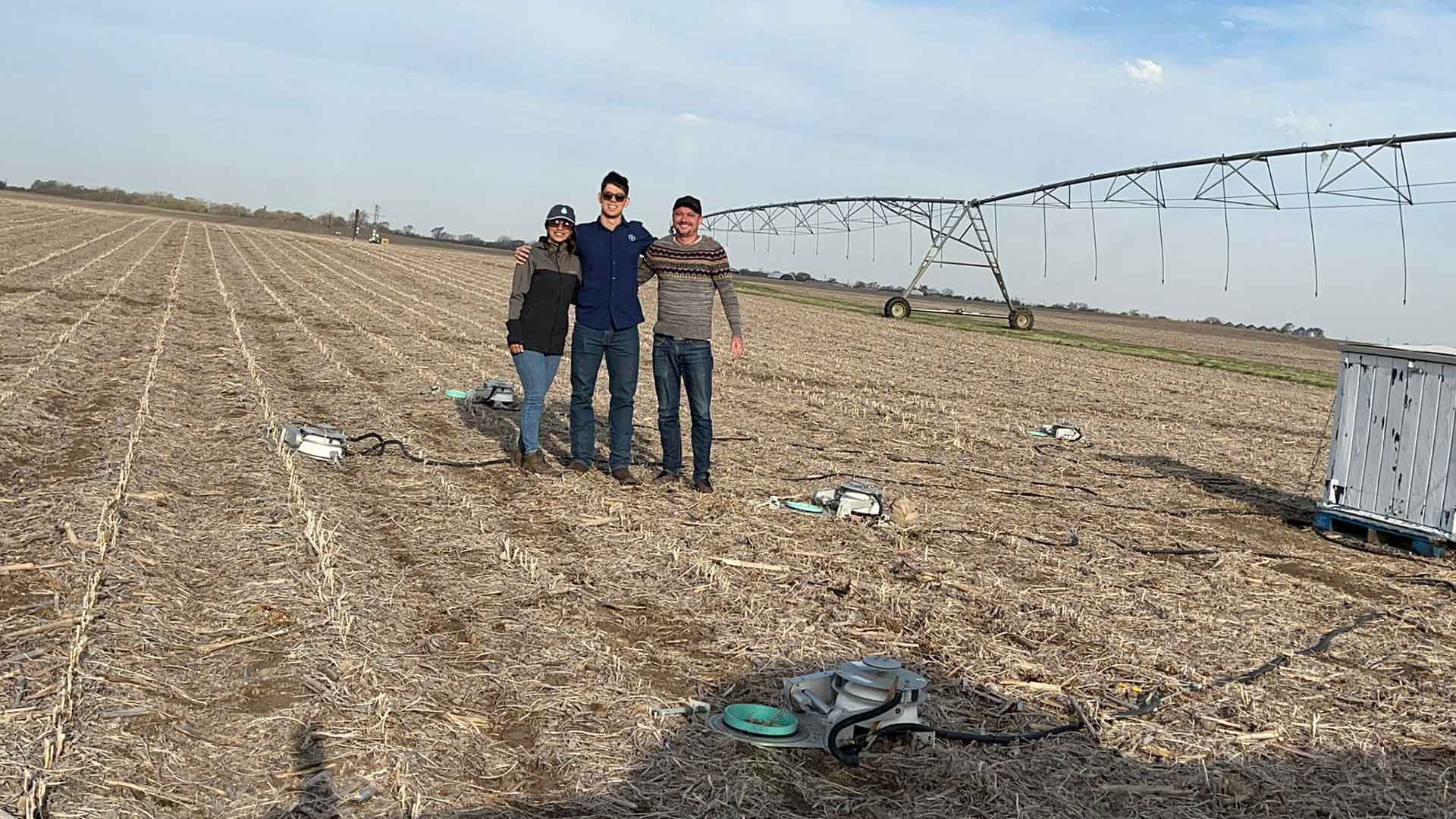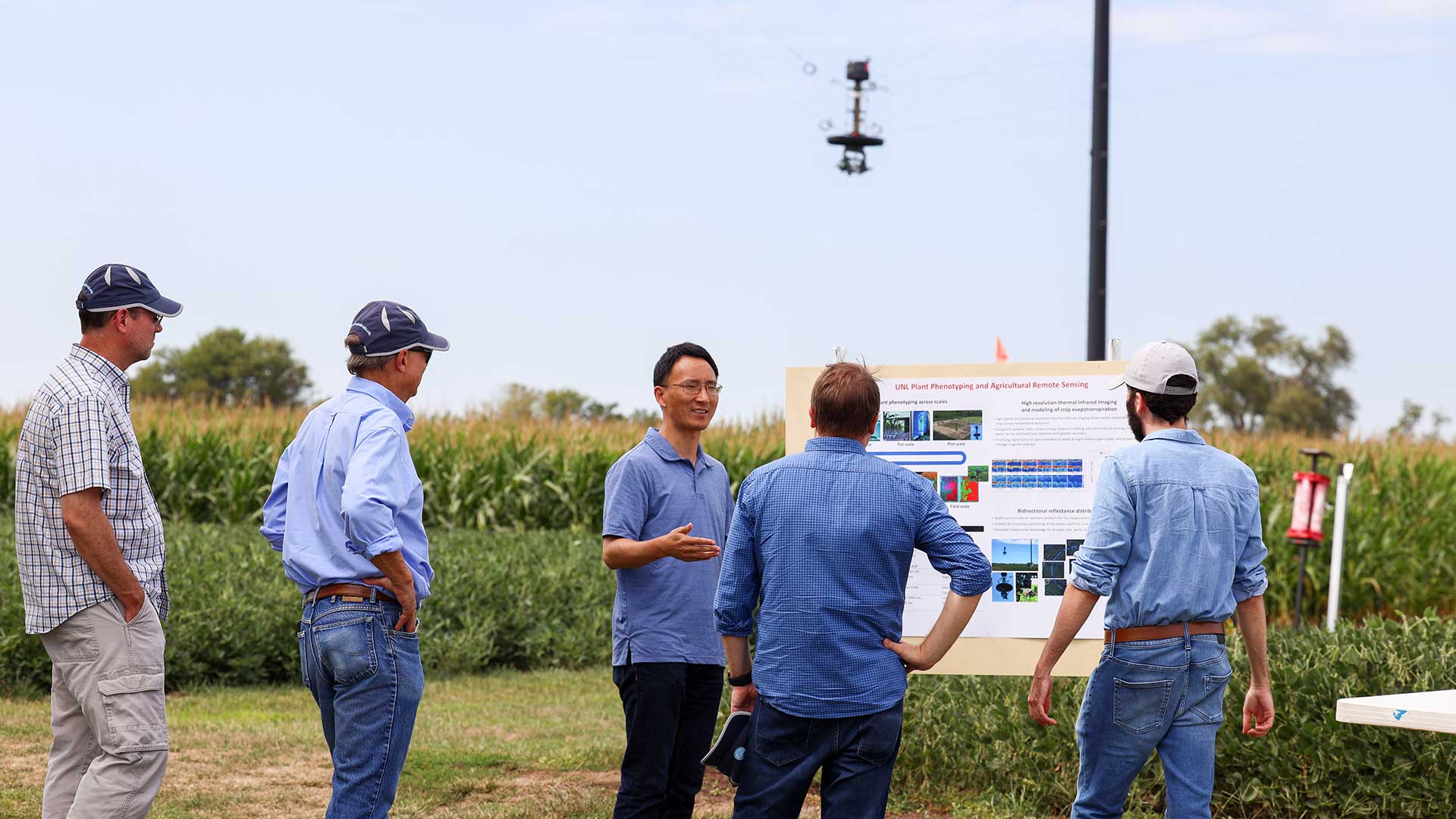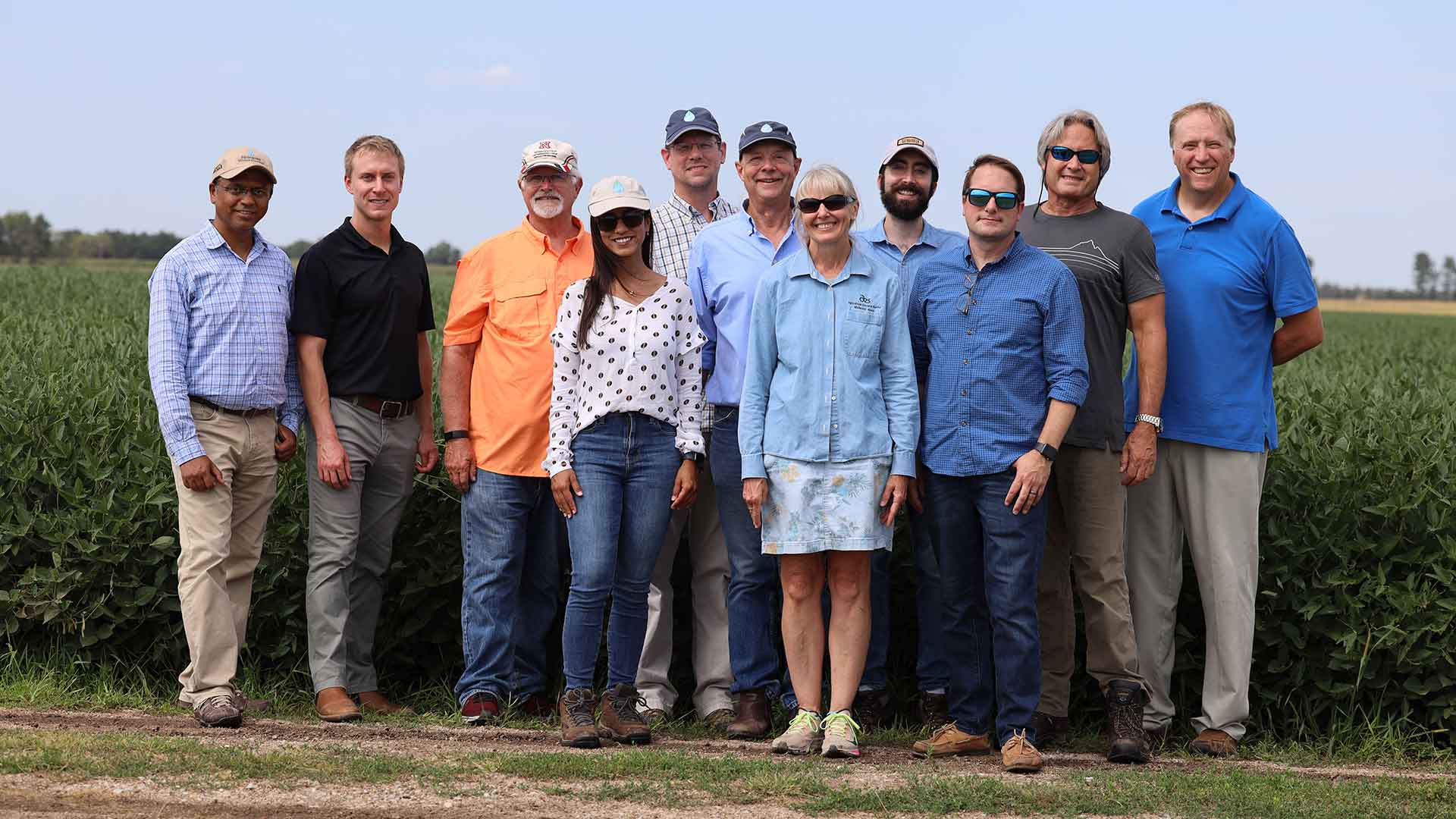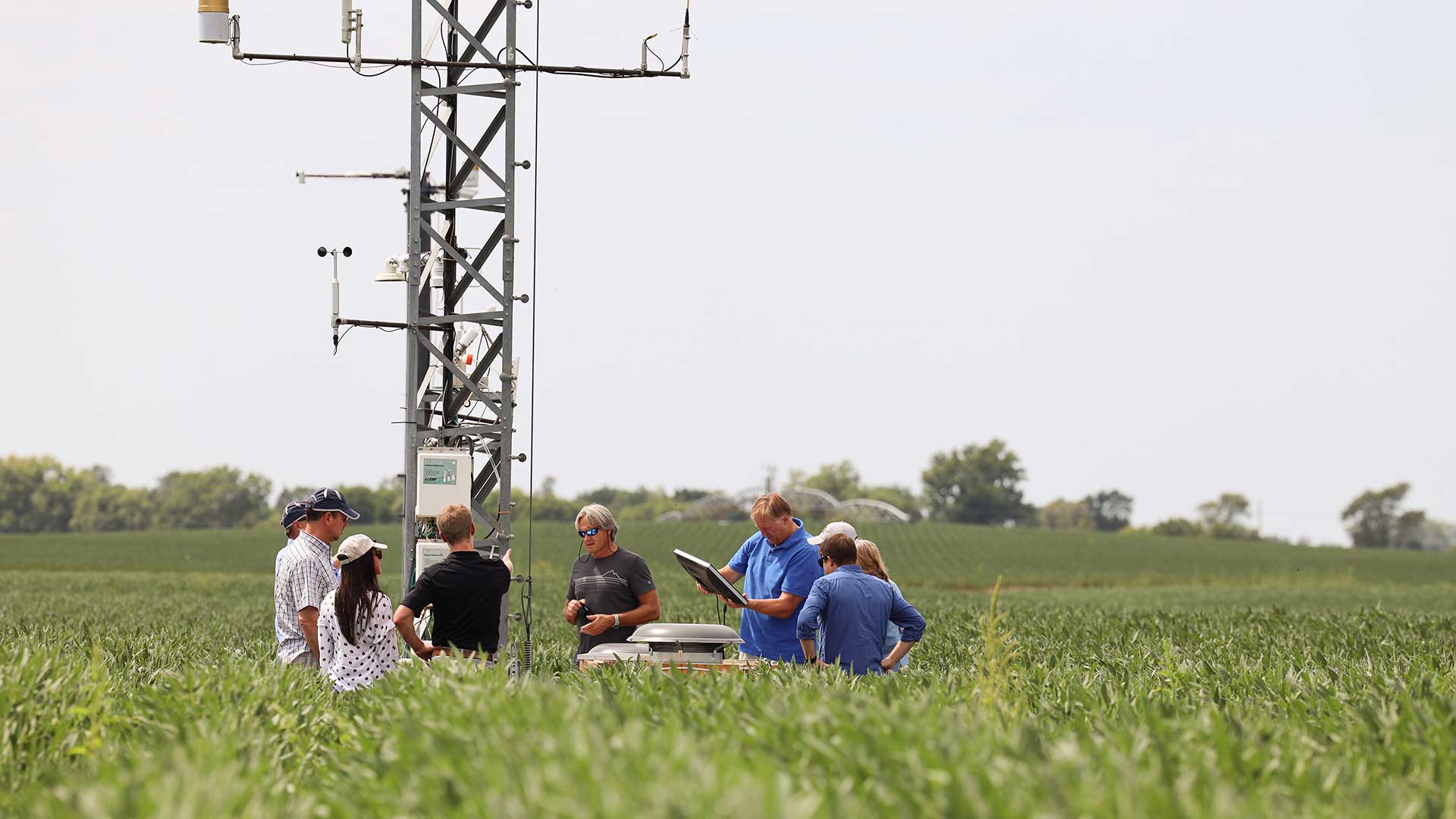DWFI's flux tower network now helps validate carbon credits
Demand is rising for carbon credits in fast-growing carbon markets. As more and more investors and businesses make carbon-neutral or carbon-negative pledges, carbon markets seek to offset greenhouse emissions by paying industries, such as agriculture, to sequester or limit them.
A farmer’s carbon credit can be represented in two ways — one, as the removal of greenhouse gasses (GHGs) from the atmosphere by capturing more of it in the soil, or two, as GHGs reduced above the soil through farming practices such as improved nitrogen application timing.
The carbon market is still relatively new and largely unregulated. Soil carbon is usually measured by samples tested periodically at a lab and participating farmers are awarded credits based on farming practices that lead to additional carbon being sequestered. However, there is a need for a simpler and faster way to quantify both carbon sequestration and GHG emissions at the field level.
In 2020, DWFI researchers received a $3 million grant from the U.S. Department of Energy (DoE) to do just that on corn fields in the Midwest. The Nebraska-led group is in its third and final year of the project and one of six tapped by the agency to do careful GHG measurements in production fields for grain crops that supply the ethanol industry. They plan to request an additional year for the project due to pandemic related delays.
The team already had existing eddy covariance flux towers deployed in Nebraska, Iowa and Minnesota that measured carbon dioxide and the vertical flux of water vapor, giving them a full picture of a crop’s total water use and carbon balance. However, the DoE project included half a million dollars in matching funds to add gas analyzers to three of these flux towers, allowing for additional measurements of soil and atmospheric nitrous oxide and methane emissions and for researchers to estimate a complete carbon balance through the use of lifecycle analysis models.
“We have three fields with three different production systems that represent thousands of fields that use similar methods,” said Christopher Neale, DWFI director of research and the lead on the project. DWFI plays a unique role in mapping the carbon cycle in corn. “There are other teams doing the same things, but on different cropping systems like rice, sorghum and other crops that are either ethanol producers or GHG emitters,” said Neale.
In September 2022, DWFI staff and partners, including UNL and USDA-ARS, hosted DoE representatives at the University of Nebraska–Lincoln’s Eastern Nebraska Research, Extension and Education Center (ENREEC) in Ithaca, Nebraska as part of the project’s review process.
Despite pandemic setbacks and a recent lightning strike on one of the towers, the team is moving ahead with their research. Jéssica Garcia Nascimento, DWFI post-doctoral research associate, is currently working with Adam Liska, DWFI Faculty Fellow and associate professor of biological systems engineering at the University of Nebraska–Lincoln, to incorporate the new data into a carbon intensity calculator model.
The updated model will show how successful certain production systems are at minimizing harmful effects of nitrous oxide emissions and their efficiency in fixing carbon. This information can then provide a profit incentive in the form of carbon credits to the farmers in future carbon markets.
“The future is the carbon credit market,” said Neale. “But we need simpler and less costly ways to accurately quantify how much carbon has been fixed.”
By ground-truthing these models, growers can accurately sell validated carbon credits using simple sensors in the future. During phase two of the project, the DoE will work with start-ups to design sensors that give farmers an immediate carbon reading.
The combination of greenhouse gas-measuring technology and modeling will lead to an increase in overall profitability as farmers adopt more efficient crop production systems that can fix more carbon and reduce emissions.
These carbon-fixing practices can have other positive outcomes. For example, planting cover crops — one of the more common practices for farmers engaged in the carbon market — can lead to better water infiltration and water holding capacity. They can also trap excess nitrogen that would otherwise leach into groundwater or runoff into nearby surface water, and release it later to feed growing crops, reducing the need for additional fertilizer.
While the team is specifically studying crops related to the ethanol industry, its research could have implications in other industries as well. Distillers' grains are a by-product of grain-based ethanol production and often used as an energy and protein source for cattle. Reducing the carbon footprint and improving the water productivity of corn grown for ethanol production can have a similar effect on the cattle industry.
Once the technology and modeling are completed, tested and perfected, they can be applied to production agriculture in other parts of the world and with different types of crops. The DWFI team and other similar DoE projects will bridge the technology gap between producers and existing market incentives to de-risk sustainable management practices, decrease the cost of monitoring their impact, reduce biofuel production emissions, and enable a future carbon farming industry.
Through this initiative, DWFI is helping shape the future carbon market and improve adoption of carbon-fixing farming practices, ultimately improving water productivity and environmental quality in Nebraska and around the globe.
FY 2023 Annual Report
- Overview
- Introduction
-
Research and Policy
-
Global
- Brazilian agricultural state looks to Nebraska and DWFI to sustainably manage water resources
- Irrigation equipment ownership not always best for smallholder farmers
- McCornick and Neale re-elected to World Water Council, DWFI involved in preparations for the World Water Forum
- Understanding the agtech ecosystem in India can spur future investments
-
Regional + National
- DAWN Project testing its decision-support tools with corn and soybean growers
- Water Center director helps City of Lincoln find second water source
- Water, Climate and Health program makes an impact in Nebraska
- DWFI's flux tower network now helps validate carbon credits
- Understanding climate’s effect on the health of Americans
- Groundwater transfer success stories guide water managers in meeting local water needs
- Advancements in crop modeling help adapt to climate change
-
Global
-
Education
- Faculty Fellows
-
Supported Students
- DWFI funds eight new students working on mission-related projects
- DWFI continues support of Platte Basin Timelapse interns
- Estimation of manure nutrient capacity in Nebraska minimizes water quality impacts
- Could cover crops replace offset in-season corn fertilizer?
- Congratulations to DWFI-supported student graduates
-
Communication
- Digital and online engagement connects DWFI with its global audience
- Coverage of DWFI research and events reaches more than 219 million people
- Creative storytelling used to amplify DWFI smallholder irrigation research outputs
- DWFI expertise tapped for national reports and publications
- DWFI staff receive well-deserved recognition
- 2022 Nebraska Water Center Annual Report now available
-
Outreach and Events
- Global Conference draws international audience to address water and food security
- On-farm event in Western Nebraska strengthens partnerships, spurs new ideas
- Engagement recovers to pre-pandemic levels
- Drought at forefront of discussions at Platte River Basin Conference
- 49th Annual Water Tour broadens knowledge about Nebraska water
- Nebraska Water Center seminars focus on hot topics in Nebraska Water
- Development
- Resources
- Search
FY 2023 Annual Report
- Overview
- Introduction
-
Research and Policy
-
Global
- Brazilian agricultural state looks to Nebraska and DWFI to sustainably manage water resources
- Irrigation equipment ownership not always best for smallholder farmers
- McCornick and Neale re-elected to World Water Council, DWFI involved in preparations for the World Water Forum
- Understanding the agtech ecosystem in India can spur future investments
-
Regional + National
- DAWN Project testing its decision-support tools with corn and soybean growers
- Water Center director helps City of Lincoln find second water source
- Water, Climate and Health program makes an impact in Nebraska
- DWFI's flux tower network now helps validate carbon credits
- Understanding climate’s effect on the health of Americans
- Groundwater transfer success stories guide water managers in meeting local water needs
- Advancements in crop modeling help adapt to climate change
-
Global
-
Education
- Faculty Fellows
-
Supported Students
- DWFI funds eight new students working on mission-related projects
- DWFI continues support of Platte Basin Timelapse interns
- Estimation of manure nutrient capacity in Nebraska minimizes water quality impacts
- Could cover crops replace offset in-season corn fertilizer?
- Congratulations to DWFI-supported student graduates
-
Communication
- Digital and online engagement connects DWFI with its global audience
- Coverage of DWFI research and events reaches more than 219 million people
- Creative storytelling used to amplify DWFI smallholder irrigation research outputs
- DWFI expertise tapped for national reports and publications
- DWFI staff receive well-deserved recognition
- 2022 Nebraska Water Center Annual Report now available
-
Outreach and Events
- Global Conference draws international audience to address water and food security
- On-farm event in Western Nebraska strengthens partnerships, spurs new ideas
- Engagement recovers to pre-pandemic levels
- Drought at forefront of discussions at Platte River Basin Conference
- 49th Annual Water Tour broadens knowledge about Nebraska water
- Nebraska Water Center seminars focus on hot topics in Nebraska Water
- Development
- Resources
- Search
Top image caption
Eddy covariance flux towers measured carbon dioxide and the vertical flux of water vapor, providing a full picture of a crop’s total water use and carbon balance.
Credit: DWFI
Related Articles
Brazilian agricultural state looks to Nebraska and DWFI to sustainably manage water resources
The Brazilian state of Mato Grosso may not appear to have much in common with Nebraska, a midwestern state of the U.S.
McCornick and Neale re-elected to World Water Council, DWFI involved in preparations for the World Water Forum
The 9th General Assembly of the World Water Council (WWC) re-elected DWFI Executive Director Peter McCornick to the council’s board of governors during its meeting in Paris in December 2022.
Understanding the agtech ecosystem in India can spur future investments
By 2030, India will have a freshwater shortfall of about 50 percent. Agriculture accounts for 78 percent of the country’s water use and irrigation innovation will be key to meeting the demand for water and food in the future.
COOKIE USAGE:
The University of Nebraska System uses cookies to give you the best online experience. By clicking "I Agree" and/or continuing to use this website without adjusting your browser settings, you accept the use of cookies.





